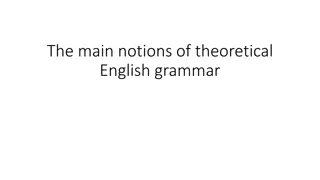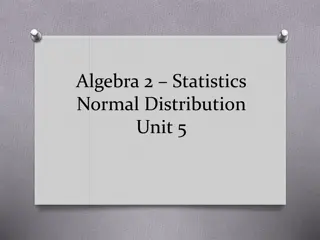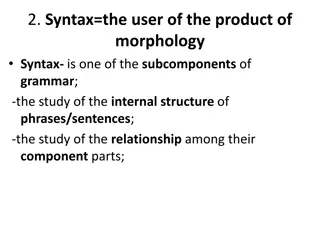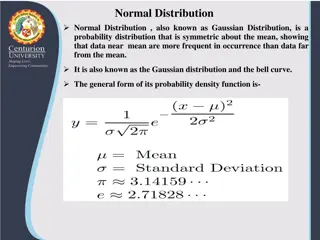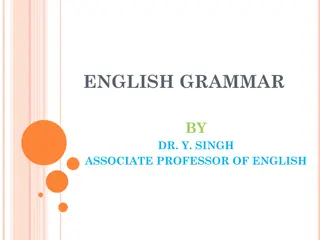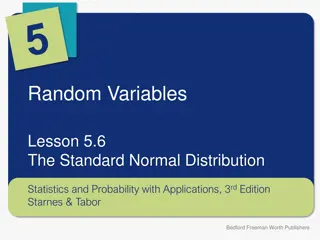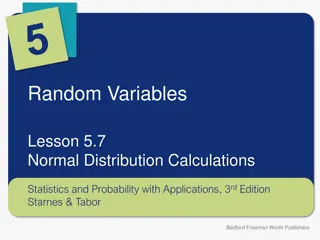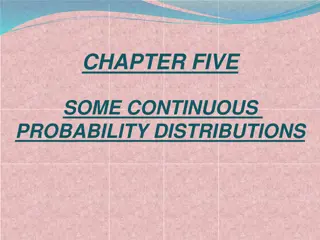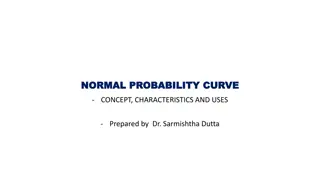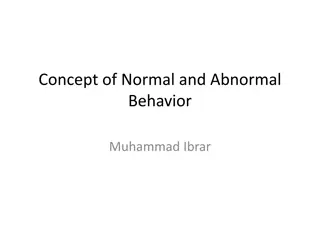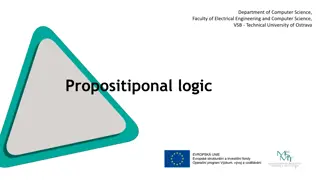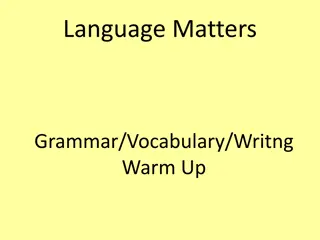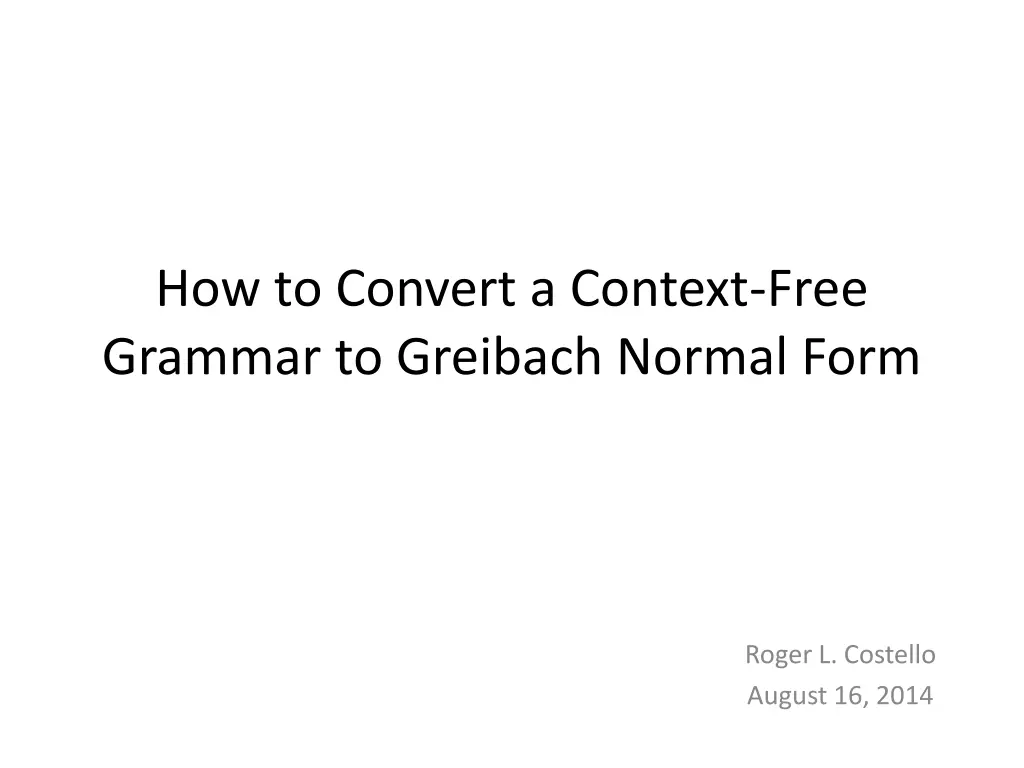
Convert Context-Free Grammar to Greibach Normal Form
Learn how to convert a context-free grammar to Greibach Normal Form, understand the benefits of this form, and see examples of grammars in Greibach Normal Form. Greibach Normal Form allows for easy string derivation with one step per symbol, resulting in efficient computations.
Download Presentation

Please find below an Image/Link to download the presentation.
The content on the website is provided AS IS for your information and personal use only. It may not be sold, licensed, or shared on other websites without obtaining consent from the author. If you encounter any issues during the download, it is possible that the publisher has removed the file from their server.
You are allowed to download the files provided on this website for personal or commercial use, subject to the condition that they are used lawfully. All files are the property of their respective owners.
The content on the website is provided AS IS for your information and personal use only. It may not be sold, licensed, or shared on other websites without obtaining consent from the author.
E N D
Presentation Transcript
How to Convert a Context-Free Grammar to Greibach Normal Form Roger L. Costello August 16, 2014
Objective This mini-tutorial will answer these questions: 1. What is Greibach Normal Form? 2
Objective This mini-tutorial will answer these questions: 1. What is Greibach Normal Form? 2. What are the benefits of having a grammar in Greibach Normal Form? 3
Objective This mini-tutorial will answer these questions: 1. What is Greibach Normal Form? 2. What are the benefits of having a grammar in Greibach Normal Form? 3. What algorithm can be used to convert a context-free grammar to Greibach Normal Form? 4
What is Greibach Normal Form? A context-free grammar is in Greibach Normal Form if the right-hand side of each rule has one terminal followed by zero or more non- terminals: A aX zero or more non-terminal symbols one terminal symbol 5
Example of a grammar in Greibach Normal Form S aB | bA A a | aS | bAA B b | bS | aBB Every right-hand side consists of exactly one terminal followed by zero or more non-terminals. 6
Example of a grammar not in Greibach Normal Form terminal at end is not allowed S aBc B b Not in Greibach Normal Form 7
What are the benefits of Greibach Normal Form? Deriving a string ? from a grammar that is in Greibach Normal Form takes one step per symbol. #?????????? ????? = |?| 8
Example derivation Grammar in Greibach Normal Form S aB | bA A a | aS | bAA B b | bS | aBB Derive this string: ?????? ? ?? ???? ????? ?????? ????? ?????? |??????| = 6 #?????????? ????? = 6 9
Contrast to a grammar thats not in Greibach Normal Form Grammar not in Greibach Normal Form S aA A B B C C a Derive this string: ?? ? ?? ?? ?? ?? |??| = 2 #?????????? ????? = 4 10
Greibach Normal Form is a Prefix Notation Grammar in Greibach Normal Form Expr +AB A 5 B *CD C 2 D 3 Derive this string: +5 23 ???? +?? +5? +5 ?? +5 2? +5 23 | + 5 23| = 5 11 #?????????? ????? = 5
Benefits of Greibach Normal Form Strings can be quickly parsed. Expressions can be efficiently evaluated. 12
Every grammar has an equivalent grammar in Greibach normal form To every -free context-free grammar we can find an equivalent grammar in Greibach normal form. 13
Grammar and its equivalent Greibach Normal Form grammar S aBC B b C c S aBc B b convert Not Greibach Normal Form Greibach Normal Form 14
Grammar and its equivalent Greibach Normal Form grammar S Bc B b S bC C c convert Not Greibach Normal Form Greibach Normal Form 15
Algorithm We have seen a couple simple examples of converting grammars to Greibach Normal Form. They didn t reveal a systematic approach to doing the conversion. The following slides show a systematic approach (i.e., algorithm) for doing the conversion. 16
But first Before we examine the algorithm, we need to understand two concepts: 1. Chomsky Normal Form 2. Left-recursive rules 17
Chomsky Normal Form We will see that the algorithm requires the grammar be converted to Chomsky Normal Form. A context-free grammar is in Chomsky Normal Form if each rule has one of these forms: 1. X a 2. X YZ That is, the right-hand side is either a single terminal or two non-terminals. See my tutorial on how to convert a context-free grammar to Chomsky normal form: http://xfront.com/formal-languages/Transforming-Context-Free-Grammars-to- Chomsky-Normal-Form.pptx 18
Left-recursive rules The algorithm requires that the grammar have no left-recursive rules. This is a left-recursive rule: Ak Ak | The alternative ( ) allows a derivation to break out of the recursion. Every left-recursive rule must have an alternative ( ) that allows breaking out of the recursion. 19
Algorithm to eliminate left-recursion Let s see how to eliminate the left-recursion in this rule: Ak Ak | The rule generates this language: n, n 1 To see this, look at a few derivations: Ak Ak Ak Ak Ak Ak Ak Ak Ak 20
Eliminate left-recursion We want to eliminate the left-recursion in this rule: Ak Ak | And we know the rule produces n We can easily generate n with this rule: An+1 An+1 | (Assume the grammar has n rules. So An+1 is a new rule that we just created.) 21
How to eliminate left-recursion The language ncan, as we ve seen, be generated using a left-recursive rule: Ak Ak | But the language can also be generated using these rules: Ak An+1 An+1 An+1 | With those two rules we have eliminated the left recursion. 22
Multiple left-recursive alternatives Of course, Ak may have multiple alternatives that are left-recursive: Ak Ak 1 | Ak 2| | Ak r And Ak may have multiple other alternatives: Ak 1 | 2| | s So Ak may generate: 1 followed by a string X: 1X s followed by a string X: s X={ 1, , r}+ X={ 1, , r}+ 23
Rule to generate {1,, r}+ We need rules to generate a string X: An+1 i An+1 i An+1 i = 1..r i = 1..r 24
Rule to generate {1,, r}+ And we need a rule to generate 1An+1, , sAn+1 : Ak i An+1 i = 1..s 25
Beautiful definition of how to eliminate left-recursion Replace this left-recursive rule: Ak Ak 1 | Ak 2| | Ak r | 1 | 2| | s By these rules: Ak i An+1 An+1 i An+1 i An+1 i = 1..s i = 1..r i = 1..r 26
Heres the algorithm to convert a grammar to Greibach Normal Form First, convert the grammar rules to Chomsky Normal Form. After doing so all the rules are in one of these forms: 1. Ai a, where a is a terminal symbol 2. Ai AjAk The first form is in Greibach Normal Form, the second isn t. Then, order the rules followed by substitution: Convert the rules to ascending order: each rule is then of the form: Ai Ai+mX After ordering, the highest rule will be in Greibach Normal Form: An aX. The next-to-highest rule will depend on the highest-rule: An-1 AnY. Substitute An with its rhs: An-1 aXY. Now that rule is in Greibach Normal Form. Continue down the rules, doing the substitution. 27 rhs = right-hand side
Apply the Algorithm to this Grammar Convert this grammar, G, to Greibach Normal Form: S Ab A aS A a First, what language does G generate? Answer: L(G) = anbn Let s derive a couple sentences to convince ourselves: ? ?? ?? ? ?? ??? ???? ???? 28
Step 1 Change the names of the non-terminal symbols to Ai S Ab A aS A a A1 A2b A2 aA1 A2 a Change S to A1, A to A2 29
Step 2 Convert the grammar to Chomsky Normal Form. A1 A2A3 A2 A4 A1 A2 a A3 b A4 a Chomsky Normal Form A1 A2b A2 aA1 A2 a 30
Step 3 Modify the rules so that the non-terminals are in ascending order. By ascending order we mean: if Ai AjX is a rule, then i < j 31
kth rule not in ascending order Suppose the first k-1 rules are in ascending order but the kth rule is not. Thus, Ak AjX is a rule and k j. 32
2 cases We want to put this rule Ak AjX into ascending order. We must deal with two cases: 1. k > j 2. k = j (left-recursive rule) 33
Case 1: k > j Ak AjX Replace this with the rhs of the rule(s) for Aj. If the resulting rule(s) is still not in ascending order, continue replacing until it is in ascending order. 34
Example A7 A10U A7 A8X A8 A15Y A9 A7Z A7 A10U A7 A8X A8 A15Y A9 A10UZ A9 A8XZ These rules are in ascending order But this is not in ascending order Replace this with the rhs of A7 Now replace this with the rhs of A8. Repeat until A9 is in ascending order. 35
Beautiful definition of how to modify Ak AjX, k > j Let Aj be this rule: Aj Y1| | Ym Replace the rule Ak AjX by these rules: Ak YiX i = 0..m Each Yi begins with either a terminal symbol or some Am where j < m. Recursively repeat the substitution for each Yi that begins with Am and k > m. 36
Avoid getting into a loop! A7 A7U A7 A8X A8 A15Y A9 A7Z Suppose we replace A7 with the rhs of this rule: We then have this: A9 A7UZ We re stuck in a loop!
Process A7 before A9 A7 A7U A7 A8X A8 A15Y A9 A7Z This rule is not in ascending order. Before processing A9 we must process A1 A8 (put them in ascending order). Earlier we showed how to eliminate left-recursion.
Worst Case: k-1 substitutions A1 A2X1 A2 A3X2 A3 A4X3 A4 A5X4 A5 A6X4 A6 A7X5 A7 A8X6 A8 A9X7 A9 A1X8 Replace this with the rhs of A1. Now we have A9 A2X1 so replace A2 with the rhs of A2. Now we have A9 A3X2X1 so replace A3 and so forth. In the worst case, for rule Ak we will need to make k-1 substitutions. 39
Apply Step 3 to our Grammar Modify the rules with k > j: A1 A2A3 A2 A4 A1 A2 a A3 b A4 a Already in order: 1 < 2 and 2 < 4 40
Case 2: k = j The grammar may have some left-recursive rules; that is, rules like this: Ak AkX We want to eliminate the left-recursion. See the earlier slides for how to eliminate left recursion. 41
Apply Case 1 and Case 2 processing to A1, then A2, then The previous slides for Step 3 might be a bit misleading. They seem to say: First process all rules where k > j and then process all rules where k = j. That is incorrect. Start at A1 and ensure it is in ascending order. Only after you ve put A1 in ascending order do you process A2. And so forth.
Eliminate left recursion in our Grammar Replace left-recursive rules: A1 A2A3 A2 A4 A1 A2 a A3 b A4 a No left-recursive rules 43
Step 4 Let An be the highest order variable (non-terminal). Then the rhs of An must be a terminal symbol (otherwise the rhs would be a non-terminal symbol, An An+1X and An+1 would be the highest order variable). The leftmost symbol on the rhs of any rule for An-1 must be either An or a terminal symbol. If it is An then replace An with the rhs of the An rule(s). Repeat for An-2, An-3, , A1. After doing this we end up with rules whose rhs starts with a terminal symbol. 44
Beautiful definition of how to modify An-1 AnX Let An be this rule: An a1Y1| | amYm Let An-1 be this rule: An-1 AnX Replace the rule An-1 AnX by these rules: An-1 aiYiX i = 0..m 45
Apply Step 4 to our Grammar Replace left-most non-terminals, working from A4 to A1: A1 A2A3 A2 A4 A1 A2 a A3 b A4 a A1 A2A3 A2 aA1 A2 a A3 b A4 a A1 aA1A3 A1 aA3 A2 aA1 A2 a A3 b A4 a Replace A2 by aA1 Replace A4 by a 46
Step 5 Change symbol names back to their original names. A1 aA1A3 A1 aA3 A2 aA1 A2 a A3 b A4 a S aSA3 S aA3 A aS A a A3 b A4 a Change A1 to S, A2 to A 47
Grammar is now in Greibach Normal Form S aSA3 S aA3 A aS A a A3 b A4 a S Ab A aS A a Not in Greibach Normal Form L(G) = anbn Greibach Normal Form L(G) = anbn 48
Unused rules S aSA3 S aA3 A aS A a A3 b A4 a Cannot reach these rules from the start symbol, S. So remove them. 49
Grammar without unused rules S aSA3 S aA3 A3 b Still in Greibach Normal Form 50

